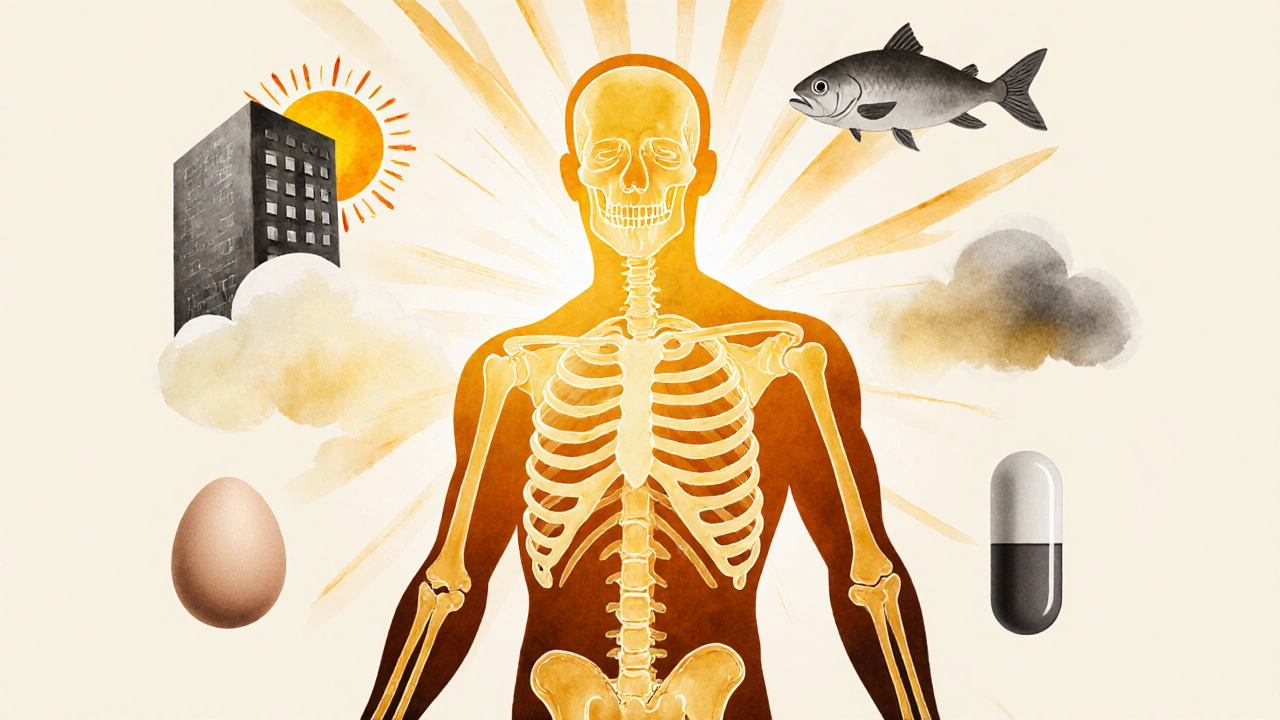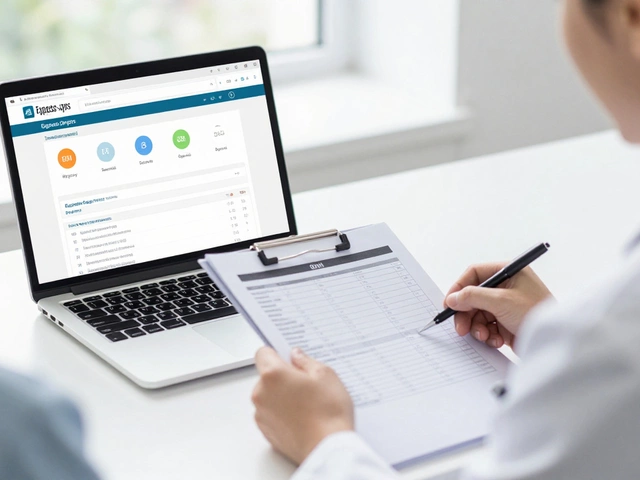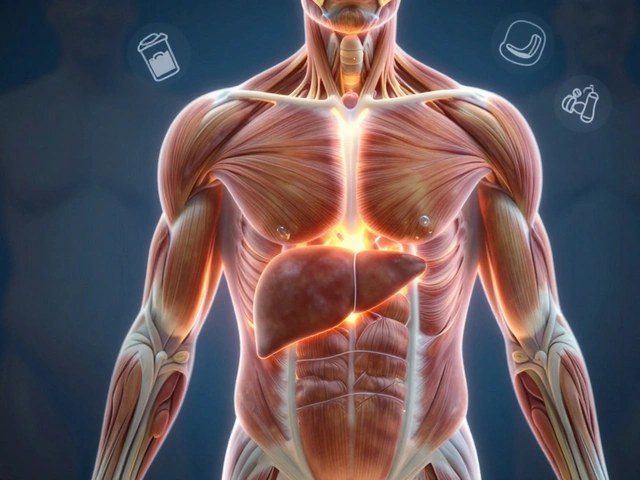Vitamin D3 Dose Calculator
Based on 2023 Indian medical studies showing 78% of urban adults are vitamin D deficient. Personalize your daily dose for optimal health.
Enter your information to see personalized vitamin D3 dosage recommendations.
Let’s cut through the noise. You’ve seen the ads-vitamin D3 for immunity, ashwagandha for stress, magnesium for sleep. But if you could only pick one supplement to take every day, what would actually move the needle for most people? Not the trendiest. Not the most expensive. Not the one with the prettiest bottle. The one that fills the biggest gap in modern diets, backed by real science, and works for almost everyone.
The Real Problem: We’re All Missing This One Nutrient
Most people in India, whether they eat a plant-based diet or meat-heavy meals, aren’t getting enough vitamin D. Not because they don’t eat well. Not because they’re unhealthy. But because of where they live, how they live, and how little time they spend in direct sunlight.
In Bangalore, even in October, the sun rises at 6 a.m. and sets at 5:45 p.m. But most people are indoors by 8 a.m.-commuting, working, studying. By the time they step outside, the sun is low or blocked by buildings. Skin exposed to sunlight makes vitamin D naturally. But with sunscreen, long sleeves, air-conditioned offices, and pollution blocking UVB rays, your body can’t make enough.
A 2023 study from the Indian Journal of Medical Research found that 78% of urban adults in South India had vitamin D levels below 30 ng/mL-the cutoff for deficiency. That’s not just low. That’s a problem. Low vitamin D links to fatigue, weakened immunity, muscle weakness, and even mood dips. It’s not a luxury. It’s foundational.
Why Vitamin D3 Is the #1 Supplement
Vitamin D3 (cholecalciferol) is the form your body naturally makes from sunlight. It’s not just a vitamin-it’s a hormone precursor. It affects over 2,000 genes. It helps your body absorb calcium. It regulates immune cells. It supports brain function and muscle strength.
Here’s what the data says:
- People with vitamin D levels above 40 ng/mL have 40% lower risk of respiratory infections, according to a 2024 meta-analysis in the British Journal of Nutrition.
- Supplementing with 2,000 IU daily raises levels safely in 90% of adults within 8 weeks.
- Deficiency is linked to higher inflammation markers-something every adult in a polluted city like Bangalore should care about.
It’s not flashy. No one sells it as a "magic fat burner" or "stress destroyer." But if you’re missing it, everything else suffers. Your immune system doesn’t work right. Your bones weaken. You feel tired even after 8 hours of sleep. You’re more prone to catching colds. And you won’t even know why.
What About Ashwagandha? Magnesium? Other Herbal Supplements?
Good question. Ashwagandha is powerful for stress. Magnesium glycinate helps with sleep and cramps. Turmeric reduces inflammation. But here’s the catch: you don’t need to take them every day to see benefits.
Ashwagandha? Take it for 8 weeks, then pause. Magnesium? Only if you have leg cramps or poor sleep. Turmeric? Works best with black pepper and fat-and you can get it from food.
Vitamin D3? You need it daily, year-round. No exceptions. It’s not about boosting performance. It’s about preventing breakdown. Your body doesn’t store it well. You don’t make enough from sun. And you can’t get enough from diet-few foods have it. Fatty fish, egg yolks, fortified milk? You’d need to eat 3 salmon fillets a day to hit 2,000 IU. Not realistic.
That’s why D3 is the #1 supplement. It’s not about being the strongest. It’s about being the most necessary.

How Much Should You Take?
Start with 2,000 IU (50 mcg) per day. That’s the safe, effective dose for most adults in India. If you’re over 60, have dark skin, or spend almost no time in the sun, 3,000 IU is fine.
Don’t go over 4,000 IU without testing. Too much can raise calcium levels and stress your kidneys. But under 4,000 IU? Very low risk.
Take it with a meal that has fat-like peanut butter on toast, ghee in rice, or a handful of almonds. Vitamin D is fat-soluble. Without fat, up to 50% of it passes through you unused.
How Do You Know If It’s Working?
You won’t feel a sudden burst of energy. But over time, you’ll notice:
- Less frequent colds-especially during monsoon or winter
- Improved mood on cloudy days
- Stronger muscles-climbing stairs feels easier
- Less joint stiffness in the morning
After 3 months, get a simple blood test: 25-hydroxyvitamin D. Ideal range is 40-60 ng/mL. If you’re under 30, keep taking 2,000-3,000 IU. If you’re over 60, you might need to stay on it longer.
What Kind of Supplement Should You Buy?
Look for these three things:
- D3 (cholecalciferol)-not D2. D2 is plant-based and less effective.
- 2,000 IU per capsule-easy to dose. No need for 10,000 IU pills.
- Third-party tested-brands like Now Foods, Nature’s Bounty, or Indian brands like Himalaya or Nutriorg have lab reports you can check.
Avoid gummies with added sugar. Avoid blends with 15 other herbs. Keep it simple. One ingredient. One dose. One goal: fix the deficiency.

What You Shouldn’t Do
Don’t wait for symptoms. By the time you feel tired or get sick often, your levels are already low.
Don’t rely on sunlight alone. Even in India, most people don’t get enough. A 15-minute walk at noon with arms exposed? Great. But only if you do it daily, without sunscreen, and your skin isn’t too dark. Most won’t.
Don’t think it’s just for older people. Young adults in cities are the most deficient. Office workers, students, delivery riders-all of them.
Don’t buy the cheapest brand. Cheap supplements often have fillers, wrong doses, or no real D3. You’re not saving money-you’re wasting time and health.
Is This the Only Supplement You’ll Ever Need?
No. But it’s the one you should start with. Once your vitamin D is in range, you can add others based on real need:
- Magnesium glycinate if you have trouble sleeping or get leg cramps
- Ashwagandha if stress is affecting your focus or appetite
- Omega-3 if you don’t eat fish twice a week
But vitamin D3? That’s the base. Like water. Like sleep. Like breathing. You don’t need to think about it every day-but you need it every day.
Final Thought: The Simplest Thing That Works
There’s no magic pill. But there is one simple, cheap, safe thing that fixes a hidden problem most people don’t even know they have.
Take 2,000 IU of vitamin D3 every morning with breakfast. For 3 months. Then check your levels. If they’re good, keep going. If they’re still low, bump it to 3,000 IU.
That’s it. No complex routines. No expensive stacks. Just one small habit that changes how your body works-under the surface, where it matters most.
Can I get enough vitamin D from sunlight alone in India?
Most people can’t. Even in sunny cities like Bangalore, daily routines-indoor work, pollution, sunscreen use, and skin pigmentation-block enough UVB exposure to make vitamin D. A 15-minute sun break at noon isn’t enough if you’re not doing it every single day without clothing or sunscreen. For most, supplementation is necessary.
Is vitamin D3 better than vitamin D2?
Yes. Vitamin D3 (cholecalciferol) is the form your skin makes from sunlight and is more effective at raising blood levels than D2 (ergocalciferol), which comes from plants. Studies show D3 raises and maintains vitamin D levels 30-50% better than D2 over time.
Can I take vitamin D3 with other herbal supplements?
Yes. Vitamin D3 works well with ashwagandha, magnesium, and turmeric. In fact, many people take them together. Just make sure you’re not taking a multivitamin that already contains vitamin D-check the label to avoid doubling up. Stick to 2,000-3,000 IU total per day unless a doctor advises otherwise.
How long does it take to feel the effects of vitamin D3?
You won’t feel it right away. Most people notice improvements in energy, mood, or immunity after 4-8 weeks. By 3 months, muscle strength and immune function typically improve noticeably. Blood tests are the only sure way to know your levels are rising.
Is vitamin D3 safe for long-term use?
Yes, at doses of 2,000-3,000 IU daily. The upper safety limit is 4,000 IU per day for adults. Taking more than that without medical supervision can raise calcium levels and harm kidneys. But within this range, long-term use is safe and recommended for people with low sun exposure.










